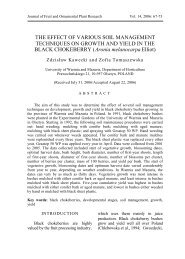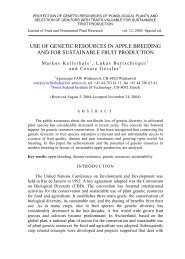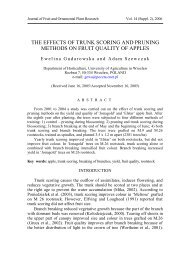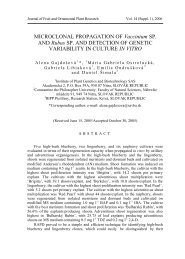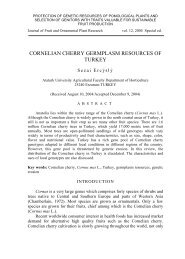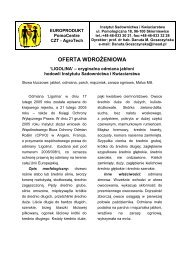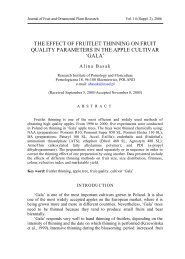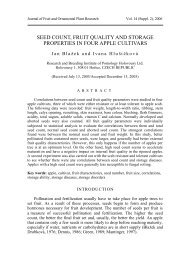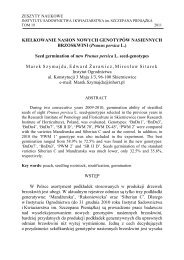Winter-hardy apricots and peaches with good fruit quality in Latvia
Winter-hardy apricots and peaches with good fruit quality in Latvia
Winter-hardy apricots and peaches with good fruit quality in Latvia
Create successful ePaper yourself
Turn your PDF publications into a flip-book with our unique Google optimized e-Paper software.
<strong>W<strong>in</strong>ter</strong><strong>hardy</strong> <strong>apricots</strong> <strong>and</strong> <strong>peaches</strong>…<strong>in</strong> <strong>Latvia</strong>the flowerer buds are damaged, especially on trees which have an abundantset of flower buds (Klav<strong>in</strong>a <strong>and</strong> Straz<strong>in</strong>ska, 1986; Solovyova, 1967).Based on the percentage of flower bud damage <strong>in</strong> 1997, the hybrids mosttolerant to large fluctuations <strong>in</strong> daily temperature were 0240329 (20%),0240851 (32%), <strong>and</strong> PU20955 (35%). These hybrids can be used as donorsof w<strong>in</strong>ter hard<strong>in</strong>ess <strong>in</strong> future breed<strong>in</strong>g programs.Regardless of weather conditions, ‘Lasma’, ‘Daiga’, ‘Ritausma’, ‘Dz<strong>in</strong>tars’,<strong>and</strong> ‘U 08248’ blossomed later than the other hybrids <strong>and</strong> cultivars <strong>in</strong> every yearof the study. They bore <strong>fruit</strong> <strong>in</strong> even the least favorable years.<strong>W<strong>in</strong>ter</strong><strong>hardy</strong> genotypes seldom have <strong>good</strong> <strong>fruit</strong> <strong>quality</strong>. Longer deepdormancy periods <strong>and</strong> later blossom<strong>in</strong>g periods are typical of wild apricotgenotypes, which generally have small <strong>fruit</strong>s of <strong>in</strong>ferior <strong>quality</strong> (Acka <strong>and</strong>Sen, 1999).The breed<strong>in</strong>g programs at the Horticultural Plant Breed<strong>in</strong>g ExperimentalStation at Dobele <strong>and</strong> the Botanical Gardens of the University of <strong>Latvia</strong> havedeveloped several apricot genotypes cultivars <strong>and</strong> hybrids which are relativelyadapted to the <strong>Latvia</strong>n climate <strong>and</strong> have <strong>good</strong> or satisfactory <strong>fruit</strong> <strong>quality</strong>(Tab. 1). Average <strong>fruit</strong> weight ranges from 13.6 to 39.8 g, average seedweight ranges from 1.6 to 2.5 g, <strong>and</strong> soluble solids content ranges from 14 to24%. Most have attractive <strong>fruit</strong>s <strong>with</strong> <strong>good</strong> separation of the stones from theflesh.Table 2. Characteristics of the best <strong>Latvia</strong>n peach cultivarsCultivar‘Maira’Average<strong>fruit</strong> weight[g]Sk<strong>in</strong>colorBlush85.7 ± 7.4 yellow largeFleshcolor‘Viktors’ 84.7 ± 5.2 yellow medium white‘ZiemeļuPersiks’67.7 ± 4.3‘Zelda’ 65.0 ± 2.1‘Rita’ 82.3 ± 7.2‘LatvijasPersiks’**97.7 ± 1.5greenishcreamgreenishcreamFirmnessmediumsoftsoftHarvest*earlylowmediummedium white soft late highlargelargeResistancetoTaphr<strong>in</strong>adeformanswhitecreammidseasonwhitecreamlatemidseasoncreamyellowcreamyellowyellowgreenishsoftmediumsoft late mediummedium yellow medium late* early – thirddecade of July or first decade of Augustmidseason – first or second decade of Augustlate midseason – secondor thirddecade of Augustlate – thirddecade of August or firstdecade of September** can be grown only <strong>in</strong> a greenhousemediumJ. Fruit Ornam. Plant Res. Special ed. vol. 12, 2004: 321329 327




